

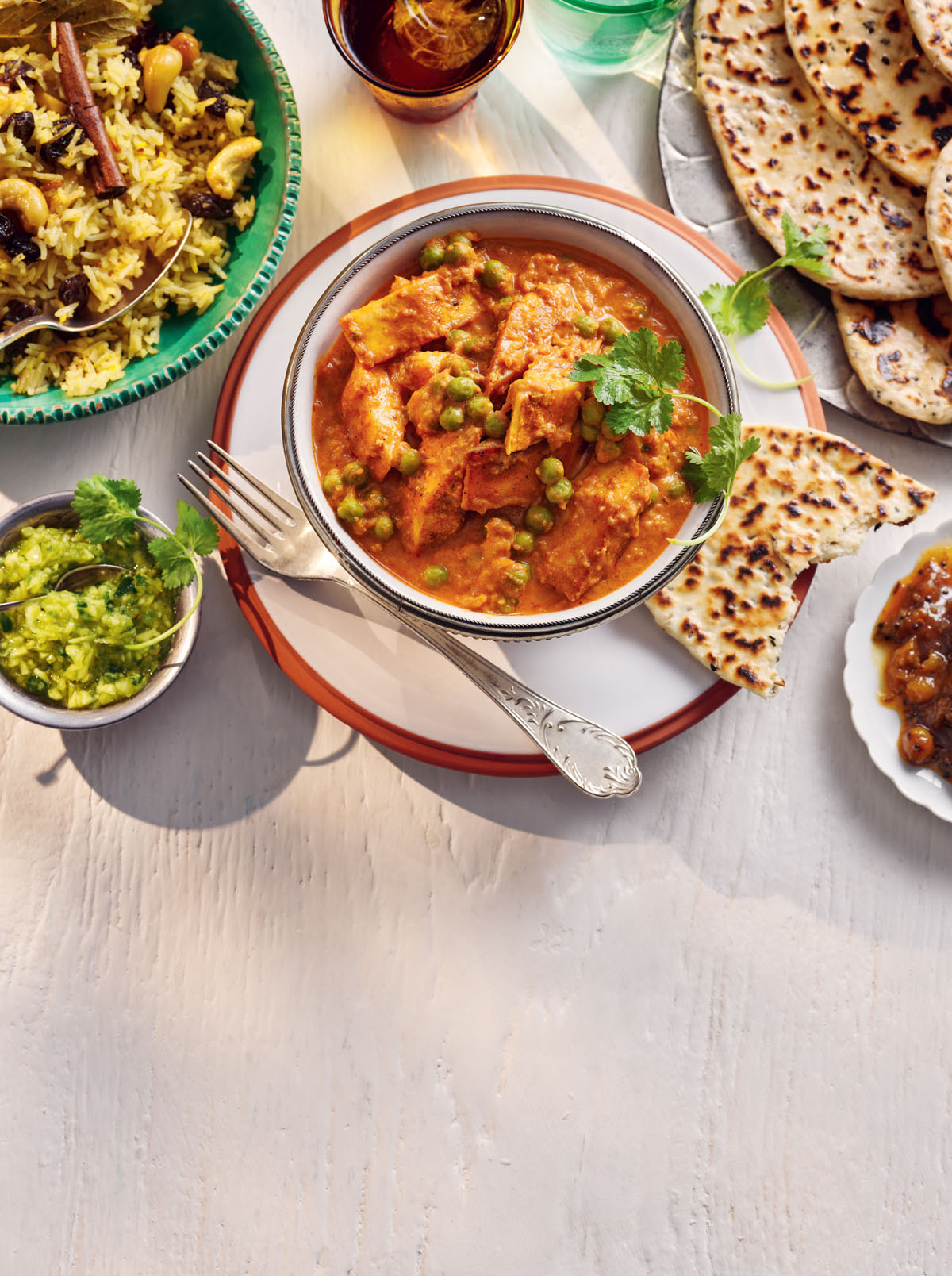
 For Ma and Monmon: the growers of this family, Gods own gardeners MEAT FREE MOWGLI Nisha Katona First published in the UK and USA in 2023 by Nourish, an imprint of Watkins Media Limited Unit 11, Shepperton House, 8393 Shepperton Road London N1 3DF Copyright Watkins Media Limited 2023 Text copyright Nisha Katona 2023 Photography copyright Gareth Morgans 2023 The right of Nisha Katona to be identified as the Author of this text has been asserted in accordance with the Copyright, Designs and Patents Act of 1988. All rights reserved. No part of this book may be reproduced in any form or by any electronic or mechanical means, including information storage and retrieval systems, without permission in writing from the publisher, except by a reviewer who may quote brief passages in a review. Publisher: Fiona Robertson Project Editor: Emily Preece-Morrison Head of Design & Art Director: Karen Smith Production: Uzma Taj Commissioned Photography: Gareth Morgans Recipe Development and Testing: Sonali Shah Additional Food Testing: Andy Mountfield Food Stylist: Bianca Nice Prop Stylist: Hannah Wilkinson A CIP record for this book is available from the British Library ISBN: 978-1-84899-411-9 (Hardback) ISBN: 978-1-84899-413-3 (eBook) 10 9 8 7 6 5 4 3 2 1 Typeset in Futura and Minion Pro Colour reproduction by XY Digital Printed in China Publishers note While every care has been taken in compiling the recipes for this book, Watkins Media Limited, or any other persons who have been involved in working on this publication, cannot accept responsibility for any errors or omissions, inadvertent or not, that may be found in the recipes or text, nor for any problems that may arise as a result of preparing one of these recipes. If you are pregnant or breastfeeding or have any special dietary requirements or medical conditions, it is advisable to consult a medical professional before following any of the recipes contained in this book. Notes on the recipes Unless otherwise stated: Use medium fruit and vegetables Use medium (US large) organic or free-range eggs Use fresh herbs, spices and chillies Use granulated sugar (Americans can use ordinary granulated sugar when caster sugar is specified) Do not mix metric, imperial and US cup measurements: 1 tsp = 5ml 1 tbsp = 15ml 1 cup = 240ml nourishbooks.com ContentsWELCOMEWelcome R aised the daughter of a Hindu Brahmin priest, there was always a fug of disdain in our house for meat eating.
For Ma and Monmon: the growers of this family, Gods own gardeners MEAT FREE MOWGLI Nisha Katona First published in the UK and USA in 2023 by Nourish, an imprint of Watkins Media Limited Unit 11, Shepperton House, 8393 Shepperton Road London N1 3DF Copyright Watkins Media Limited 2023 Text copyright Nisha Katona 2023 Photography copyright Gareth Morgans 2023 The right of Nisha Katona to be identified as the Author of this text has been asserted in accordance with the Copyright, Designs and Patents Act of 1988. All rights reserved. No part of this book may be reproduced in any form or by any electronic or mechanical means, including information storage and retrieval systems, without permission in writing from the publisher, except by a reviewer who may quote brief passages in a review. Publisher: Fiona Robertson Project Editor: Emily Preece-Morrison Head of Design & Art Director: Karen Smith Production: Uzma Taj Commissioned Photography: Gareth Morgans Recipe Development and Testing: Sonali Shah Additional Food Testing: Andy Mountfield Food Stylist: Bianca Nice Prop Stylist: Hannah Wilkinson A CIP record for this book is available from the British Library ISBN: 978-1-84899-411-9 (Hardback) ISBN: 978-1-84899-413-3 (eBook) 10 9 8 7 6 5 4 3 2 1 Typeset in Futura and Minion Pro Colour reproduction by XY Digital Printed in China Publishers note While every care has been taken in compiling the recipes for this book, Watkins Media Limited, or any other persons who have been involved in working on this publication, cannot accept responsibility for any errors or omissions, inadvertent or not, that may be found in the recipes or text, nor for any problems that may arise as a result of preparing one of these recipes. If you are pregnant or breastfeeding or have any special dietary requirements or medical conditions, it is advisable to consult a medical professional before following any of the recipes contained in this book. Notes on the recipes Unless otherwise stated: Use medium fruit and vegetables Use medium (US large) organic or free-range eggs Use fresh herbs, spices and chillies Use granulated sugar (Americans can use ordinary granulated sugar when caster sugar is specified) Do not mix metric, imperial and US cup measurements: 1 tsp = 5ml 1 tbsp = 15ml 1 cup = 240ml nourishbooks.com ContentsWELCOMEWelcome R aised the daughter of a Hindu Brahmin priest, there was always a fug of disdain in our house for meat eating.
My parents were, as were many first generation immigrants, keen horticulturalists who grew spinach, beets, radishes, squashes and used and cooked every part of them. Stems, flowers, leaves and even the peelings. Hinduism, you see, suggests that the fierce energy used to digest heavy meats should be channelled into philosophy and deep thought, into fathoming how to make the world a better place. In India, eateries will presume you are vegetarian a minor area of the menu will be labelled non-veg items, from which one may order with a little blush of shame. While I am not a vegetarian or vegan, I, like many others, have wholeheartedly embraced the need to eat less meat and more veg, both for my own health and that of the planet. As an Indian chef, this felt like the most natural thing in the world, as our cuisine is so heavily geared toward seasonal vegetable-heavy menus anyway.
Indian food is the perfect go-to cuisine for the modern family that wants to eat less meat. And thus, the idea for Meat Free Mowgli was born a collection of simple, plant-based meals in the Mowgli style we know and love. The Indian meat-free kitchen is one with aeons of heritage. For thousands of years, the average Indian home kitchen has celebrated vegetables with each passing season. While not all religions advocate vegetarianism or veganism, at least a quarter of Indias population are strictly vegetarian, so the eating of plant-based dishes is ingrained in our society. This means there are so many wonderful options to choose from that putting together this collection of recipes was a dream.
The Indian spices that I love enhance and highlight the naturally wonderful flavours of plants so effortlessly. When I started planning this book I knew that I wanted the recipes to be as simple and stress-free as possible. Like most people, I need the recipes I cook at home to fit into my busy life and want them to be on the table in as short a time as possible! And the glory of cooking with vegetables is that they are at their best when cooked exactly that way simply and quickly. With a few basic spices in your arsenal, most vegetables can be cooked in a pan dry-fry style, and you have an enormous recipe repertoire at your disposal just like that! Some recipe ideas are a little more time-consuming, requiring a slower cook in a delicious sauce or the careful layering of a biryani, for example, but none are complex. I also wanted to include a good proportion of vegan dishes. (Again, such a natural thing in Indian cuisine, where in the hot climate, dairy is a treat ingredient rather than an everyday necessity.) With the exception of the Eggs and Dairy chapter, a selection of yogurt-based raitas in various chapters, and a handful of recipes where a slick of butter, the binding quality of an egg or a dash of milk is necessary, Im pleased to say that the majority of the book is in fact vegan.
Where a vegan substitute can be made, I have noted it. You will find a few Mowgli vegetarian menu classics here, such as the Ruby Wraps (on ). There are some new takes on my favourite dals, sides, salads and slaws, and some ideas for accompaniments, from naans to puris to rice dishes. There are plenty of sweets and drinks for good measure, too. I hope you will enjoy this selection of plant-based recipes. Whether you are a vegetarian or vegan looking for new ideas, or a meat-eater looking for ways to bring more vegetables into your diet, Meat Free Mowgli is intended to inspire and spice up your life.
Tuck in Nisha Katona Photography: Kats Films Katrina Lipska
Photography: Kats Films Katrina Lipska  INTRODUCTION
INTRODUCTION About This Book I n order to be as useful as possible, I have decided to order the chapters in this book according to the main groups of vegetables. Roots and Alliums; Gourds; Nightshades (an unusual but evocative word for the collection that includes tomatoes, peppers and aubergines/eggplant); Beans, Peas and Lentils; Brassicas and Leafy Greens; and Fruit all group together quite naturally. Eggs and Dairy warranted a separate chapter to make things easy for vegans trying to navigate the book (although always check each recipe there may be a small but necessary dash of butter or milk in a handful of recipes). Finally, I have combined those that fitted less easily into one group into a chapter entitled Mushrooms and More; here you will find sweetcorn, tofu and veggie mince, and some nut- and grain-based recipes. Find yourself with a glut of potatoes or courgettes/zucchinis? Simply turn to the relevant chapter and discover a collection of fantastic options to try. But dont stop there the beauty of veg is that they work in endless delicious combinations.
About This Book I n order to be as useful as possible, I have decided to order the chapters in this book according to the main groups of vegetables. Roots and Alliums; Gourds; Nightshades (an unusual but evocative word for the collection that includes tomatoes, peppers and aubergines/eggplant); Beans, Peas and Lentils; Brassicas and Leafy Greens; and Fruit all group together quite naturally. Eggs and Dairy warranted a separate chapter to make things easy for vegans trying to navigate the book (although always check each recipe there may be a small but necessary dash of butter or milk in a handful of recipes). Finally, I have combined those that fitted less easily into one group into a chapter entitled Mushrooms and More; here you will find sweetcorn, tofu and veggie mince, and some nut- and grain-based recipes. Find yourself with a glut of potatoes or courgettes/zucchinis? Simply turn to the relevant chapter and discover a collection of fantastic options to try. But dont stop there the beauty of veg is that they work in endless delicious combinations.
Next page
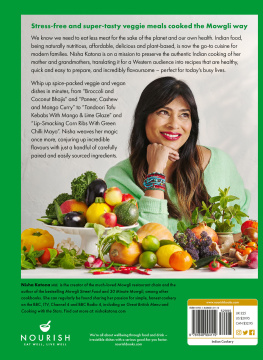
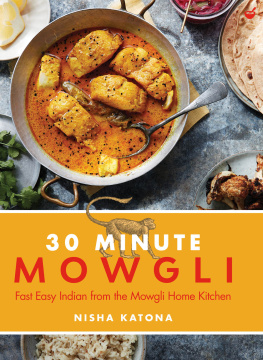

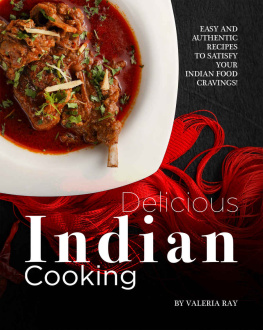
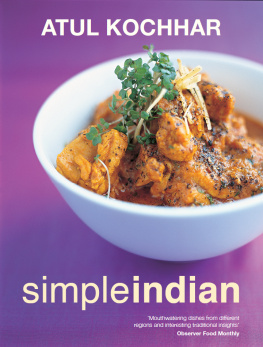

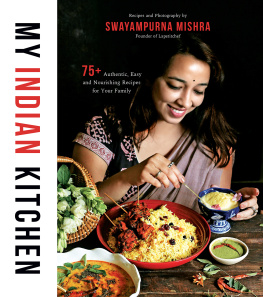
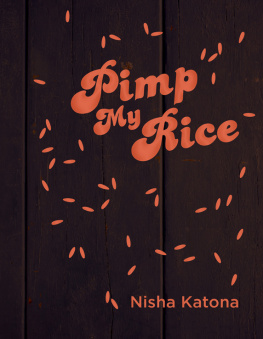
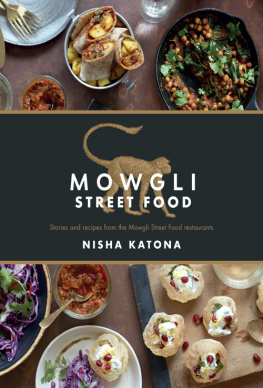

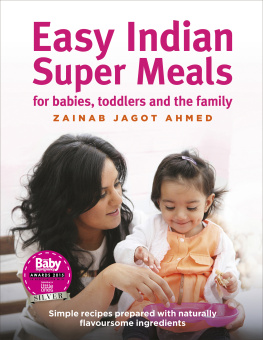
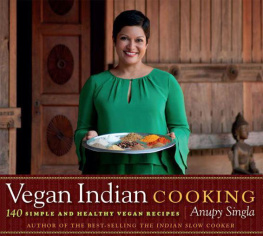
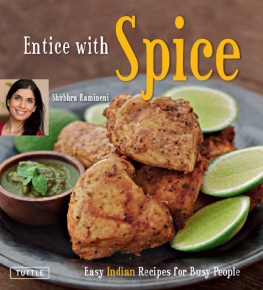



 For Ma and Monmon: the growers of this family, Gods own gardeners MEAT FREE MOWGLI Nisha Katona First published in the UK and USA in 2023 by Nourish, an imprint of Watkins Media Limited Unit 11, Shepperton House, 8393 Shepperton Road London N1 3DF Copyright Watkins Media Limited 2023 Text copyright Nisha Katona 2023 Photography copyright Gareth Morgans 2023 The right of Nisha Katona to be identified as the Author of this text has been asserted in accordance with the Copyright, Designs and Patents Act of 1988. All rights reserved. No part of this book may be reproduced in any form or by any electronic or mechanical means, including information storage and retrieval systems, without permission in writing from the publisher, except by a reviewer who may quote brief passages in a review. Publisher: Fiona Robertson Project Editor: Emily Preece-Morrison Head of Design & Art Director: Karen Smith Production: Uzma Taj Commissioned Photography: Gareth Morgans Recipe Development and Testing: Sonali Shah Additional Food Testing: Andy Mountfield Food Stylist: Bianca Nice Prop Stylist: Hannah Wilkinson A CIP record for this book is available from the British Library ISBN: 978-1-84899-411-9 (Hardback) ISBN: 978-1-84899-413-3 (eBook) 10 9 8 7 6 5 4 3 2 1 Typeset in Futura and Minion Pro Colour reproduction by XY Digital Printed in China Publishers note While every care has been taken in compiling the recipes for this book, Watkins Media Limited, or any other persons who have been involved in working on this publication, cannot accept responsibility for any errors or omissions, inadvertent or not, that may be found in the recipes or text, nor for any problems that may arise as a result of preparing one of these recipes. If you are pregnant or breastfeeding or have any special dietary requirements or medical conditions, it is advisable to consult a medical professional before following any of the recipes contained in this book. Notes on the recipes Unless otherwise stated: Use medium fruit and vegetables Use medium (US large) organic or free-range eggs Use fresh herbs, spices and chillies Use granulated sugar (Americans can use ordinary granulated sugar when caster sugar is specified) Do not mix metric, imperial and US cup measurements: 1 tsp = 5ml 1 tbsp = 15ml 1 cup = 240ml nourishbooks.com ContentsWELCOMEWelcome R aised the daughter of a Hindu Brahmin priest, there was always a fug of disdain in our house for meat eating.
For Ma and Monmon: the growers of this family, Gods own gardeners MEAT FREE MOWGLI Nisha Katona First published in the UK and USA in 2023 by Nourish, an imprint of Watkins Media Limited Unit 11, Shepperton House, 8393 Shepperton Road London N1 3DF Copyright Watkins Media Limited 2023 Text copyright Nisha Katona 2023 Photography copyright Gareth Morgans 2023 The right of Nisha Katona to be identified as the Author of this text has been asserted in accordance with the Copyright, Designs and Patents Act of 1988. All rights reserved. No part of this book may be reproduced in any form or by any electronic or mechanical means, including information storage and retrieval systems, without permission in writing from the publisher, except by a reviewer who may quote brief passages in a review. Publisher: Fiona Robertson Project Editor: Emily Preece-Morrison Head of Design & Art Director: Karen Smith Production: Uzma Taj Commissioned Photography: Gareth Morgans Recipe Development and Testing: Sonali Shah Additional Food Testing: Andy Mountfield Food Stylist: Bianca Nice Prop Stylist: Hannah Wilkinson A CIP record for this book is available from the British Library ISBN: 978-1-84899-411-9 (Hardback) ISBN: 978-1-84899-413-3 (eBook) 10 9 8 7 6 5 4 3 2 1 Typeset in Futura and Minion Pro Colour reproduction by XY Digital Printed in China Publishers note While every care has been taken in compiling the recipes for this book, Watkins Media Limited, or any other persons who have been involved in working on this publication, cannot accept responsibility for any errors or omissions, inadvertent or not, that may be found in the recipes or text, nor for any problems that may arise as a result of preparing one of these recipes. If you are pregnant or breastfeeding or have any special dietary requirements or medical conditions, it is advisable to consult a medical professional before following any of the recipes contained in this book. Notes on the recipes Unless otherwise stated: Use medium fruit and vegetables Use medium (US large) organic or free-range eggs Use fresh herbs, spices and chillies Use granulated sugar (Americans can use ordinary granulated sugar when caster sugar is specified) Do not mix metric, imperial and US cup measurements: 1 tsp = 5ml 1 tbsp = 15ml 1 cup = 240ml nourishbooks.com ContentsWELCOMEWelcome R aised the daughter of a Hindu Brahmin priest, there was always a fug of disdain in our house for meat eating. Photography: Kats Films Katrina Lipska
Photography: Kats Films Katrina Lipska  INTRODUCTION
INTRODUCTION About This Book I n order to be as useful as possible, I have decided to order the chapters in this book according to the main groups of vegetables. Roots and Alliums; Gourds; Nightshades (an unusual but evocative word for the collection that includes tomatoes, peppers and aubergines/eggplant); Beans, Peas and Lentils; Brassicas and Leafy Greens; and Fruit all group together quite naturally. Eggs and Dairy warranted a separate chapter to make things easy for vegans trying to navigate the book (although always check each recipe there may be a small but necessary dash of butter or milk in a handful of recipes). Finally, I have combined those that fitted less easily into one group into a chapter entitled Mushrooms and More; here you will find sweetcorn, tofu and veggie mince, and some nut- and grain-based recipes. Find yourself with a glut of potatoes or courgettes/zucchinis? Simply turn to the relevant chapter and discover a collection of fantastic options to try. But dont stop there the beauty of veg is that they work in endless delicious combinations.
About This Book I n order to be as useful as possible, I have decided to order the chapters in this book according to the main groups of vegetables. Roots and Alliums; Gourds; Nightshades (an unusual but evocative word for the collection that includes tomatoes, peppers and aubergines/eggplant); Beans, Peas and Lentils; Brassicas and Leafy Greens; and Fruit all group together quite naturally. Eggs and Dairy warranted a separate chapter to make things easy for vegans trying to navigate the book (although always check each recipe there may be a small but necessary dash of butter or milk in a handful of recipes). Finally, I have combined those that fitted less easily into one group into a chapter entitled Mushrooms and More; here you will find sweetcorn, tofu and veggie mince, and some nut- and grain-based recipes. Find yourself with a glut of potatoes or courgettes/zucchinis? Simply turn to the relevant chapter and discover a collection of fantastic options to try. But dont stop there the beauty of veg is that they work in endless delicious combinations.